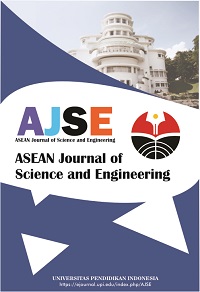Paracord Anklet and Bracelet Controls Against Mosquitoes
Abstract
Keywords
Full Text:
PDFReferences
Alali, F. Q., Liu, X. X., and Mclaughlin, J. L. (1999). Annonaceous acetogenins: Recent progress. Journal of Natural Products, 62(3), 504-540.
Batish, D. R., Singh, H. P., Kohli, R. K., and Kaur, S. (2008). Eucalyptus essential oil as a natural pesticide. Forest Ecology and Management, 256(12), 2166-2174.
De Los Reyes, A. A., and Escaner IV, J. M. L. (2018). Dengue in the Philippines: Model and analysis of parameters affecting transmission. Journal of Biological Dynamics, 12(1), 894-912.
Elsiddig, F. (2011). Effect of organic extracts of cafure leaves (eucalyptus camaldulensis dehn.) on mosquitoes (anopheles arabiensis patton.). Gezira Journal of Agricultural Science, 9(2).
Govindarajan, M., and Benelli, G. (2016). Artemisia absinthium-borne compounds as novel larvicides: Effectiveness against six mosquito vectors and acute toxicity on non-target aquatic organisms. Parasitology Research, 115(12), 4649-4661.
Govindarajan, M., Sivakumar, R., Rajeswari, M., and Yogalakshmi, K. (2012). Chemical composition and larvicidal activity of essential oil from mentha spicata (linn.) against three mosquito species. Parasitology Research, 110(5), 2023-2032.
Hui, Y. H., Rupprecht, J. K., Anderson, J. E., Wood, K. V., and Mclaughlin, J. L. (1991). bullatalicinone, a new potent bioactive acetogenin, and squamocin from annona bullata (annonaceae). Phytotherapy Research, 5(3), 124-129.
Jaenson, T. G., Garboui, S., and Pålsson, K. (2006). Repellency of oils of lemon eucalyptus, geranium, and lavender and the mosquito repellent mygga natural to ixodes ricinus (acari: ixodidae) the laboratory and field. Journal of Medical Entomology, 43(4), 731-736.
Kazembe, T., and Samuel, J. E. R. E. (2012). malaria control with mosquito repellent plants: colophospermum mopane, dicoma anomala and lippia javanica. World Journal of Life Sciences and Medical Research, 2(4), 141.
Rodrigues, A. M., Silva, A. A. S., Pinto, C. C. C., Santos, D. L. D., Freitas, J. C. C. D., Martins, V. E. P., and Morais, S. M. D. (2019). Larvicidal and enzymatic inhibition effects of annona muricata seed extract and main constituent annonacin against aedes aegypti and aedes albopictus (Diptera: Culicidae). Pharmaceuticals, 12(3), 112.
Sakulku, U., Nuchuchua, O., Uawongyart, N., Puttipipatkhachorn, S., Soottitantawat, A., and Ruktanonchai, U. (2009). Characterization and mosquito repellent activity of citronella oil nanoemulsion. International Journal of Pharmaceutics, 372(1-2), 105-111.
Yimer, S., and Sahu, O. (2014). Anti-mosquito repellent from artemisia annua. International Journal of Medical Sciencesi, 1(1), 1-8.
DOI: https://doi.org/10.17509/ajse.v1i1.33766
Refbacks
- There are currently no refbacks.
Copyright (c) 1970 Universitas Pendidikan Indonesia

This work is licensed under a Creative Commons Attribution-ShareAlike 4.0 International License.












